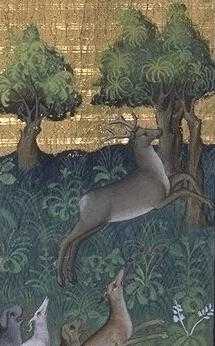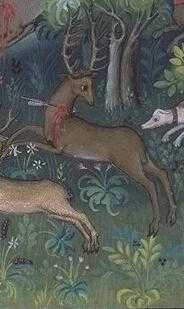 Deer,
once an important cultural symbol of Western Civilization, have slowly
lost the meaning and importance they once so proudly held. In early
21st
century America the usefulness of this noble animal has been more or
less
degraded to an annual licensed season where, temporarily, they regain
their
status of old as beasts of the hunt. The rest of the year, however,
they
are considered destructive and a nuisance - many a farmer and gardener
have crops ruined by foraging deer, and their errant wanderings across
busy
highways and roads lead to automobile accidents which cause injury and
even death to both deer and motorist. Thanks to Walt Disney and Bambi
there
is a sort of fuzzy affection for the beast, but for modern man, deer
are
mostly bothersome creatures one sees tied to the top of pick-up trucks
every Autumn, or lying dead next to the highway in various decaying
pieces. Deer,
once an important cultural symbol of Western Civilization, have slowly
lost the meaning and importance they once so proudly held. In early
21st
century America the usefulness of this noble animal has been more or
less
degraded to an annual licensed season where, temporarily, they regain
their
status of old as beasts of the hunt. The rest of the year, however,
they
are considered destructive and a nuisance - many a farmer and gardener
have crops ruined by foraging deer, and their errant wanderings across
busy
highways and roads lead to automobile accidents which cause injury and
even death to both deer and motorist. Thanks to Walt Disney and Bambi
there
is a sort of fuzzy affection for the beast, but for modern man, deer
are
mostly bothersome creatures one sees tied to the top of pick-up trucks
every Autumn, or lying dead next to the highway in various decaying
pieces.

|
To medieval man,
however, deer were more than just an annoying nuisance
and occasional object of the hunt; they were a primary source of food,
resources, and inspiration. In addition to providing an important
source
of diet and protein for much of the medieval population, their hides
made
excellent leather suitable for clothing and other necessary items, and
their bones and antlers were carved into useful and decorative objects.
Artists lavishly used the deer for both imagery and symbolism in
paintings,
tapestries, manuscripts, and even embroidery. They were the subjects of
stories and myths, and in their pursuit man found great entertainment
and
sport.
Kings and the upper
classes prized the deer and called it a noble
beast, and hunting them for game became an honor that was usually
reserved
for "gentlemen." Peasants were forbidden by law to hunt any large
animals,
and many of the deer used for food purposes usually came from reserved
stocks and deer parks. Hunting & killing a deer on restricted land
could often mean death or long imprisonment for an unlucky commoner.
Today
for illegally killing a deer the State Police will simply haul the
offender
off to court and lavish a fine. Unpleasant, but far less severe.
|

Medieval man, not
blessed with gun or car, killed his
deer with bow and arrow, an often dangerous pursuit for both hunter
&
beast. (A famous example is King William II, who was accidentally
killed
in the New Forest while hunting a stag.) To bring the animal down
quickly
some form of poison was often used. The 14th c. Goodman of Paris
recommended
the following procedure:
"Poison for killing
a stag or wild boar: Take the
root of wolfsbane, pound it in a mortar, put it in a sack or small
cloth,
and squeeze it to get the juice. Put this juice in a dish in the sun,
and
at night keep it under cover and dry so that no water or moisture can
touch
it. Move it in and out of the heat until it is glutinous and formed
like
thickened wax, and then put it in a tightly closed box. When you want
to
shoot an arrow, put some of it between the barbs and the iron socket,
so
that the beast will be struck down when it hits and makes contact with
the flesh. If the iron is not smeared in this way, when it enters the
skin
of the beast, the ointment stays there and the strike will be worth
nothing."
|
 |
|
 Deer,
once an important cultural symbol of Western Civilization, have slowly
lost the meaning and importance they once so proudly held. In early
21st
century America the usefulness of this noble animal has been more or
less
degraded to an annual licensed season where, temporarily, they regain
their
status of old as beasts of the hunt. The rest of the year, however,
they
are considered destructive and a nuisance - many a farmer and gardener
have crops ruined by foraging deer, and their errant wanderings across
busy
highways and roads lead to automobile accidents which cause injury and
even death to both deer and motorist. Thanks to Walt Disney and Bambi
there
is a sort of fuzzy affection for the beast, but for modern man, deer
are
mostly bothersome creatures one sees tied to the top of pick-up trucks
every Autumn, or lying dead next to the highway in various decaying
pieces.
Deer,
once an important cultural symbol of Western Civilization, have slowly
lost the meaning and importance they once so proudly held. In early
21st
century America the usefulness of this noble animal has been more or
less
degraded to an annual licensed season where, temporarily, they regain
their
status of old as beasts of the hunt. The rest of the year, however,
they
are considered destructive and a nuisance - many a farmer and gardener
have crops ruined by foraging deer, and their errant wanderings across
busy
highways and roads lead to automobile accidents which cause injury and
even death to both deer and motorist. Thanks to Walt Disney and Bambi
there
is a sort of fuzzy affection for the beast, but for modern man, deer
are
mostly bothersome creatures one sees tied to the top of pick-up trucks
every Autumn, or lying dead next to the highway in various decaying
pieces.
